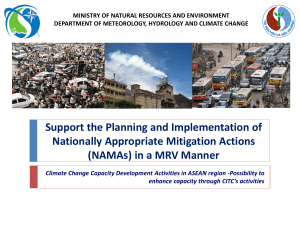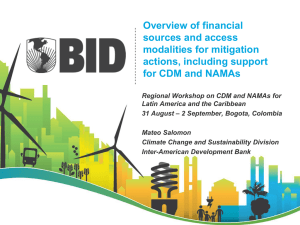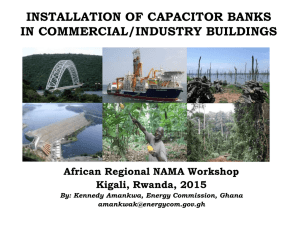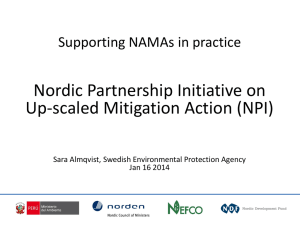cơ sở xây dựng hệ thống đo đạc, báo cáo, thẩm định (cho việt nam
advertisement
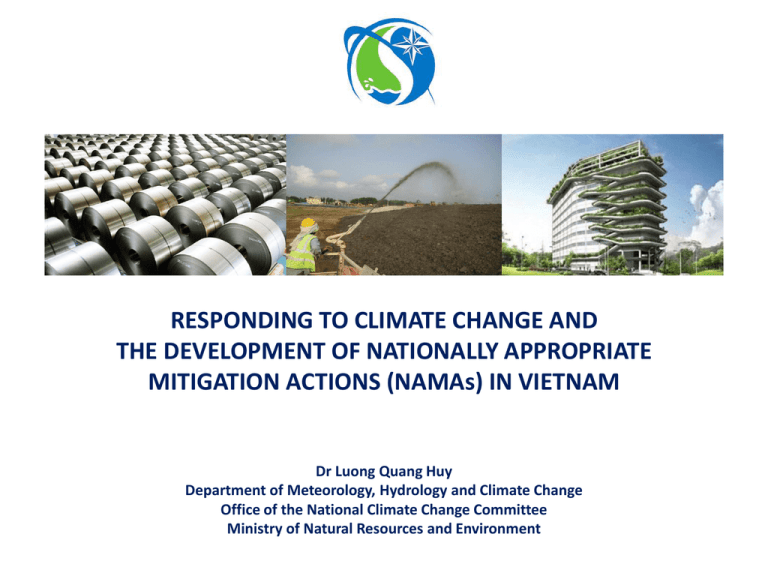
CƠ SỞ XÂY DỰNG HỆ THỐNG ĐO ĐẠC, BÁO CÁO, THẨM ĐỊNH (CHO VIỆT NAM RESPONDING TO CLIMATE CHANGE AND THE DEVELOPMENT OF NATIONALLY APPROPRIATE MITIGATION ACTIONS (NAMAs) IN VIETNAM Dr Luong Quang Huy Department of Meteorology, Hydrology and Climate Change Office of the National Climate Change Committee Ministry of Natural Resources and Environment Context 1. 2. 3. 4. 5. Climate change in Vietnam, Greenhouse gas emission reduction options, Strategic changes in responding to climate change, Legal foundation to support NAMA development, Plan of GHG emission management and management of carbon trading activities to the world market, 6. Priority areas of NAMA management and coordination, 7. Priorities to improve management and coordination 8. Some concluding remarks. Climate change in Vietnam Overview • Climate change will continue to negatively affect Vietnam; • Vietnam's key resources and economic sector are highly vulnerable; • Deltas and coastal areas are worst affected; • Red River Delta and Mekong Delta is particularly vulnerable areas. Climate change in Vietnam Climate change impacts in Vietnam – In the past 50 years, the average annual temperature has increased by about 0.5oC; – Increased rainfall in rainy season (May 5-11); – Large floods occurs more frequently in the Central and the South; – Reduced rainfall in dry season (May 7, 8); – Annual serious droughts in most areas of the country; – Climate change increases natural disasters, especially hurricanes, floods, and droughts. Risk of reversing achievement in poverty reduction, the Millennium Development Goals and sustainable development. Climate change in Vietnam • Vietnam climate change scenarios (2012) – At the end of the 21st century, temperature may increase by 2.3 ° C compared to 1980-1999; – Temperature increases from 1.6 to 2.8 ° C; that of northern and north central increase faster than the south; – Winter temperatures may increase higher than summer temperatures. – Total rainfall in rainy season increase, rainfall during dry season tends to decrease in the South; – Precipitation may increase about 5% compared with 1980-1999; that of the North increase higher than the South. – Sea level rise of about 30 cm (2050) and 75cm (2100) compared to 1980 -1999. Climate change and policy development United Nations Framework Convention on Climate Change(UNFCCC) and Kyoto Protocol (KP) • Vietnam signed the United Nations Framework Convention on Climate Change (UNFCCC) on 11 June 1992 and ratified on 16 November 1994; • Vietnam signed Kyoto Protocol (KP) on 03 December 1998 and ratified on 25 September 2002. • Vietnam has no obligation to reduce emissions, but the general obligations of developing the National Communications, GHG inventory, develop mitigation options and adaptation measures... • Agenda 21 of Vietnam (Vietnam Agenda 21) - August / 2004 has a number of objectives related to the response to climate change GHG emissions in 1994 and 2000 and 2010 Source: BUR1 (MONRE, 2014) Estimated GHG emissions in 2010, 2020 and 2030. Source: BUR1 (MONRE, 2014) Greenhouse gas emission reduction options Energy sector Options Code Emission reduction potential Incremental cost* (million tCO2e) (US$ million) Emission reduction cost* Use high performance air conditioning Converting to LPG in transport sector Converting to ethanol in transport sector Biomass thermopower to replace coal-fired thermopower E1 39,083 -68,868 ($/tCO2) -7,8 E2 4,726 -15,614 -10,9 E3 12,265 70,497 19,2 E4 57,343 69,390 4,8 Development of small hydropower Wind power instead of coalfired power Total E5 55,741 -75,117 -4,7 E6 68,145 668,888 41,1 237,303 Greenhouse gas emission reduction options Agriculture sector Options A1: Alternate wetting and drying irrigation, System of Rice Intensification (AWD-SRI) A2: Re-using rice crop residues as composting products Total Emission reduction Emission reduction potential cost (US$/ tonCO2e) (million tons CO2e) 1.47 76.3 9.34 10.81 -59.1 Greenhouse gas emission reduction options LULUCF Options Emission reduction potential (million tCO2e) F1: Mixed planting of indigenous wood trees with centralized method. F2: Zoning, regeneration of forest with planting of native trees under forest canopy. 504.17 1.3 151.29 1.6 F3: Community Forest Management under the forestry socialization policy with planting of native trees planted under forest canopy 137.30 0.9 Total 792.76 Emission reduction cost (US$/ tonCO2) Greenhouse gas emission reduction options Energy sector Options Code Emission reduction potential Incremental cost* (million tCO2e) (US$ million) Emission reduction cost* Use high performance air conditioning Converting to LPG in transport sector Converting to ethanol in transport sector Biomass thermopower to replace coal-fired thermopower E1 39,083 -68,868 ($/tCO2) -7,8 E2 4,726 -15,614 -10,9 E3 12,265 70,497 19,2 E4 57,343 69,390 4,8 Development of small hydropower Wind power instead of coalfired power Total E5 55,741 -75,117 -4,7 E6 68,145 668,888 41,1 237,303 Legal foundation at international level • UNFCCC-COP decisions and negotiations – Bali Action Plan (BAP – COP13 - 2007): adopted NAMA in MRV manner – Copenhagen (COP15 - 2009): NAMA narrowed down to developing countries – Cancun (COP16 – 2010): need for further commitment based on CBDR-RC and developing countries shall implement NAMAs with support (f, t, cb) from Annex 1. – Durban (COP17 – 2011): 48 countries (now 50) submitted NAMAs (intention only). – Doha (COP18 – 2012): registry to be adopted, supports from Annex 1 to be committed and increased, financial mechanism (GCF) to be operated. – Warsaw (COP19-2013): Launch of NAMA registry, issue of NAMA guidance based on countries’ experience, fine-tune of GCF mechanism to support NAMA development. – Lima (COP20, 2014): Developing countries agreed to craft Nationally Appropriate Mitigation Actions (NAMAs) that are in line with their national development objectives. Through NAMAs, developing countries aim to reduce their emissions below business as usual by 2020. Legal foundation in Vietnam • National Climate Change Strategy (Decision 2139/QD-TTg) – “Consider low-carbon economy and green growth as principles in achieving sustainable development; GHG emission reduction and removal to become a mandatory index in social and economic development”. • National Green Growth Strategy (Decision 1393/QD-TTg ) – “Green growth, low-carbon economy, and enrichment of natural resources become the mainstream of sustainable economic development; GHG emission reduction and sink enhancement become mandatory and important criteria for socio-economic development”. • Plan of GHG emission management and management of carbon trading activities to the world market (Decision 1775/QD-TTg) – “Preparation of framework and action plans for NAMAs to be internationally registered and widely implemented” – “Development and operation of MRV system” Priority areas of works (visualisation) Actors / factors in NAMA management and coordination NAMA readiness GHG Inventory BAU formulation Monitoring Institutional Framework Advisory Mechanism Reporting Verification National MRV system Crediting NAMA Pilot case studies Negotiation Financial & Technical support Training, Education & capacity building Current NAMA management and coordination NAMA in national policies Current NAMA management and coordination Current NAMA management system NAMA Focal point / Registry / Guidance are under development Current NAMA management and coordination NAMA management and coordination at global scale and in Vietnam Global scale UNFCCC Private sectors Financial institutions / mechanisms Bilateral/Multilateral cooperation Vietnam Private sectors Banks, financial mechanism Inter-sectoral cooperation IPCC SBSTA SBI WG1 WG2 WG3 Working groups NAMA Registry GoV/NCCC Provinces MONRE Ministries DONREs Relevant agencies NAMA Registry / Focal point / Guidance Departments Current NAMA management and coordination NAMA management and coordination Private sectors Banks, financial mechanism Inter-sectoral cooperation Requirements for supports Financial aids / supports / loans GoV/NCCC MONRE Ministries Relevant agencies NAMA Registry / Focal point / Guidance Line ministries provide sectoral guidance, M&E, MRV DONREs and other line departments provide appraisal and approval processes Companies / Enterprises / Community groups develop NAMAs Research institutes Third parties provide methodologies Authorised agencies provide M&E and MRV Requirements for reporting, verifications and M&E Provisions of M&E, MRV services Challenges and gaps in NAMA management and coordination • Gaps analyses – NAMA institutional framework have not been established and recommendations of specific policies at national and local level to develop, implement and manage NAMAs are developed and submitted to competent authorities for consideration; – NAMA reporting and verification (R&V) systems at national level have not been developed and operational; – Roadmap for implementation of NAMAs with quantitative reduction targets has not been developed and submitted to competent authorities for approval; – Communication and capacity building programmes on NAMAs for national and provincial practitioners are inadequate. Priorities to improve management and coordination • Institutional arrangement and policies – Review all legal documents on mitigation actions, NAMAs and JCM mechanism; – In-depth survey and analyses on institutional arrangement. – Development of institutional framework. – Development of an Action Plan to develop and manage NAMA. – Identify policy barriers to mitigation measures, NAMAs and JCM. – Establishment of NAMA Advisory Identity. – Development of NAMA advisory network. – Formalise the NAMA Advisory Identity in the form of PM’s decision. – Annual and periodical consultation meetings and workshops. Priorities to improve management and coordination – Guidelines and information systems • Development of a series of guidelines for complying with reporting and verification procedure. • Development of a national and publicly accessible information system. • Development of policies to formalize the reporting and verification system. • Establishment of a forum on reporting and verification procedures. Priorities to improve management and coordination • Technical / methodological issues – Review of potential NAMAs – Identify priority areas / sectors – Developing a set of criteria to select unilateral NAMA projects. – Identifying potential NAMAs for reducing GHGs emission below a Business-as-Usual (BAU) – Develop strategic roadmap for NAMA – Prioritizing potential NAMAs for international support – Identifying and prioritize potential NAMAs for the national, provincial and local policy level. Priorities to improve management and coordination • Training and education – Central level – Training and support activities for improvement of capacity in • (i) NAMA and climate change financing, • (ii) NAMA technical issues at UNFCC level and • (iii) NAMA capacity building supported by Annex 1 countries to Non-Annex 1 countries and (iv) JCM – Improvement of Vietnam’s participation and policy positions for relevant UNFCCC contact groups on NAMAs. – A national programme to improve negotiation capacity for negotiation team on NAMAs. – Provincial level / private sectors – Training programme for NAMA development, implementation and management and JCM activities for private sectors. – Training programme for department level at local provinces for state management authorities. MINISTRY OF NATURAL RESOURCES AND ENVIRONMENT DEPARTMENT OF METEOROLOGY, HYDROLOGY AND CLIMATE CHANGE Thank you!
